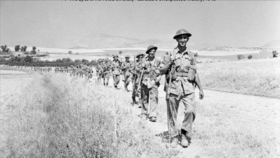Battle of Runikhata: Difference between revisions
No edit summary |
No edit summary |
||
| Line 15: | Line 15: | ||
* {{flagicon image|Erebonian Flag.jpg|22px}} [[Erebonian Empire]]<br/> | * {{flagicon image|Erebonian Flag.jpg|22px}} [[Erebonian Empire]]<br/> | ||
* {{flagicon image|Flag of Rubrum1 T E.jpg|22px}} [[Rubrum and the Peristylium|Rubrum]]<br/> | * {{flagicon image|Flag of Rubrum1 T E.jpg|22px}} [[Rubrum and the Peristylium|Rubrum]]<br/> | ||
* {{flagicon image|2000px-Flag of the Republic of China.svg.png|22px}} [[Provisional Government of the Republic of Taoyuan|Taoyuanese Provisional Government]]<br/> | |||
}} | }} | ||
| Line 28: | Line 29: | ||
* {{flagicon image|Erebonian Flag.jpg|22px}} [[Brian Regnitz]]<br/> | * {{flagicon image|Erebonian Flag.jpg|22px}} [[Brian Regnitz]]<br/> | ||
* {{flagicon image|Flag of Rubrum1 T E.jpg|22px}} [[Elliot Testarossa]]<br/> | * {{flagicon image|Flag of Rubrum1 T E.jpg|22px}} [[Elliot Testarossa]]<br/> | ||
* {{flagicon image|2000px-Flag of the Republic of China.svg.png|22px}} [[Song Li-jen]]<br/> | |||
}} | }} | ||
| Line 35: | Line 37: | ||
* {{flagicon image|East europan imperial alliance 11666.jpg|22px}} {{flagicon image|Flag of the Schutzstaffel.svg|22px}} [[Benno Vogel Strecker]]<br/> | * {{flagicon image|East europan imperial alliance 11666.jpg|22px}} {{flagicon image|Flag of the Schutzstaffel.svg|22px}} [[Benno Vogel Strecker]]<br/> | ||
* {{flagicon image|Quen minh 691036.jpg|22px}} [[Trương Ngọc Thái Bình]] <br/> | * {{flagicon image|Quen minh 691036.jpg|22px}} [[Trương Ngọc Thái Bình]] <br/> | ||
}} | }} | ||
| strength1 = 55,000 troops<br/> 120 tanks<br/> 100 aircraft<br/> 50 guns<br/> | | strength1 = 55,000 troops<br/> 120 tanks<br/> 100 aircraft<br/> 50 guns<br/> | ||
| strength2 = | | strength2 = 90,000 troops<br/> 200 tanks<br/> 120 aircraft<br/> 90 guns<br/> | ||
| casualties1 = Moderate | | casualties1 = Moderate | ||
| casualties2 = Heavy | | casualties2 = Heavy | ||
Revision as of 09:54, 17 May 2023
| Battle of Runikhata | |||||||
|---|---|---|---|---|---|---|---|
| Part of the Nepali-Bhutania Campaign of the Second Europan War | |||||||
 ERUAC forces marching to Jakar following the Battle of Runikhata | |||||||
| |||||||
| Belligerents | |||||||
| Commanders and leaders | |||||||
| Strength | |||||||
|
55,000 troops 120 tanks 100 aircraft 50 guns |
90,000 troops 200 tanks 120 aircraft 90 guns | ||||||
| Casualties and losses | |||||||
| Moderate | Heavy | ||||||
The Battle of Runikhata (9 August - 12 August 1943) was a battle that took place on the eponymous town. It was fought between elements of the 2nd ERUIF and Reichmacht and crack SS divisions. The battle took place as a result of Quenminese Marshal Mạc Hiếu Quang ordering Alexander Sundermann to attempt to halt and bottle up Regnitz relief force from getting into Jakar.
After Regnitz had successfully isolated Marshal Trương Ngọc Thái Bình's forces during the Battle of Tashigang, the original plan was for them to rendezvous with Sugiyama in Bhutania by marching towards the border town of Zhemgang. As they headed for the town, they would receive a radio transmission from Sugiyama, ordering them to turn around and swing south to reinforce the Bethausians as Jakar, where Marshal Mạc Hiếu Quang was attempting to destroy Allied forces in the lowlands as part of the Manas River Offensive. While his suboordinates, including Testarossa were skeptical of moving the entire corps south through the mountainous terrain, Regnitz was unfazed, determined to relieve Allied forces in the lowlands. When he asked for an estimate of their arrival to General Arkar's position, he was told it would take nearly 14 days to move the entire army group south. Regnitz rebutted and told his generals to make it less than 6 days. In 7 August, they set off for Jakar. ERUAC columns would have difficulty of traversing the mountainous roads and bends that two-way roads turned into one way traffic.
A Luftwaffe reconnaissance plane spotted the ERUAC column and immediately reported it to Marshal Quang. Immediately, he ordered East Europan forces consisting of both Reichmacht and the Waffen-SS to go to Runikhata to attempt to bottle down Regnitz. In August 9, after 3 days of non-stop movement, the ERUAC forces had finally arrived on the lowlands and proceeded to march to Runikhata, the last town before Jakar. The ERUAC forces were greeted by volleys of fire from the defenders at Runikhata. Regnitz and Testarossa encountered heavy resistance and engaged Imperial forces for the next 2 days at Runikhata, turning the town into a bloody close quarters battle for the town. Crack SS formations under General Alfred Toht Kiesling were sent to attempt a pincer attack against Regnitz, determined to destroy the relief force and surround the ERUACs. But elements of the 6th Erebonian Armoured Division clashed on the western outskirts of the town. Although the SS offered stiff resistance, ERUAC forces had managed to blunt the attempt, allowing the 7th Rubrumian Division to split from the main force and encircle Reichmacht units on the eastern flank of the town. Although progress was slow, a breakthrough was reached when outnumbered elements of the Princess Victoria's Taoyuanese Rifles pressed a mix of bayonet and dadao charges onto the elements of SS units on the southern outskirts of the town, which had prevented from General Benno Vogel Strecker from sending in more reinforcements. By the night of 12 August, the East Europan forces were forced off Runikhata, leaving 5,000 encircled troops to be captured by ERUAC forces, allowing Regnitz to continue his march to Jakar.
The failure of East Europan forces to halt Regnitz at the town not only allowed the latter to relieve the Bethausians at Jakar, but also robbed the Imperial forces of a near victory on the Manas River Offensive.